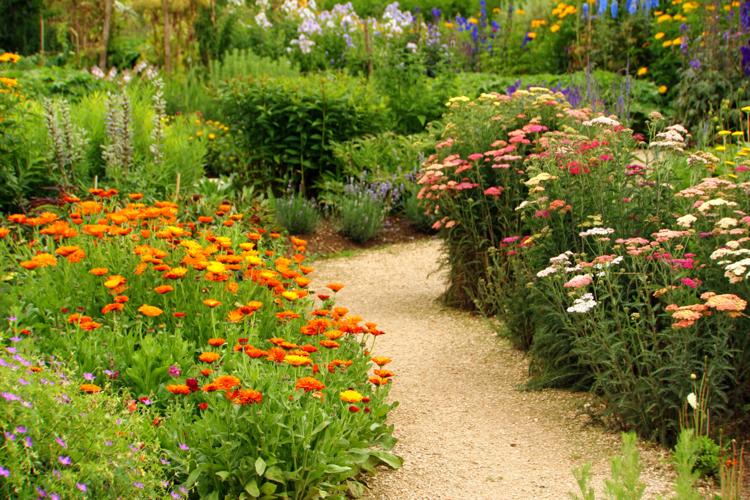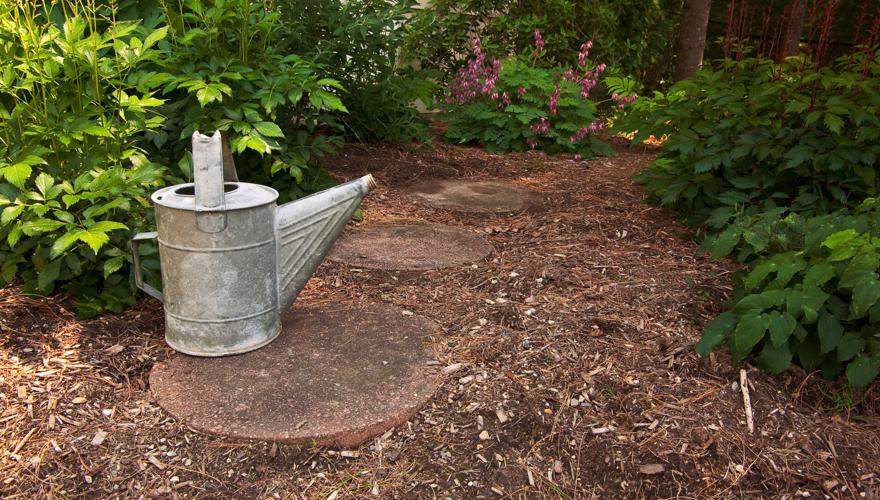Garden paths are a key component of your garden’s design. Not only do they serve a practical function, they also help define your garden’s style.
You should first determine the type of garden style you have, or would like. That will help you narrow down the shape and type of path materials that will best match your desired look. For more information on garden styles and design, you can take a look at my article “How to design a desert garden”.
Garden paths are key to the flow of a garden, and they can help with elements of style such as balance and delineation of space. When considering materials for your garden path, think about the style of your garden. Probably the most important question to ask yourself is: Is my garden formal or informal? Formal gardens generally have constructed paths with pavers, bricks or other hardscaping. Informal gardens may have gravel, mulch or natural stone.
The shape of your path can also depend on how formal you want your space to be. Straight paths delineate spaces into very clear areas and look more constructed and formal. This can work well with modern styles or Mediterranean gardens, for example. Curvy paths, and ones with borders that blend into the plants, look more natural and encourage the eye to look at the overall landscape rather than the constructed elements.

You can mix path materials like mulch and pavers, particularly in informal gardens.
It’s critical to consider how wide you want your path. For maximum access, paths should be 4-5 feet wide. However, it’s perfectly fine to have main paths that are accessible to everyone and smaller, informal paths that lead into smaller spaces. This type of space delineation can make a smaller space seem bigger, because you have several different types of spaces within the main area. Consider if you need access for wheelchairs, garden carts or wheelbarrows, or pool or landscaping equipment such as Bobcats.
Another critical consideration in your design is water flow and drainage. Water flow is particularly critical in our desert. It’s best to avoid lots of uninterrupted hardscaping that encourages water to flow off it rather than soaking in. This wastes water that could be used in your garden and contributes to water pollution and overloading of our water treatment plants. Pavers and bricks are good alternatives to surfaces like concrete or asphalt, and encourage water to soak into the soil in your yard.
In addition, be sure to consider maintenance. Tree roots, digging critters, erosion and similar factors will all impact your paths over time. For example, I would recommend against putting concrete over areas that have tree roots. If you want hardscaping in an area under a tree, choose pavers or bricks, which will move when roots grow under them, rather than cracking. It's less expensive to fix pavers than it is to break up and re-pour concrete. If you live in the middle of the desert, you may also consider whether gravel paths are feasible for you. On the plus side, they are easy to fix and maintain. However, you may get intrusion from digging rodents or even ants that affect your paths. You may want to consider chicken wire or hardware cloth under your path if this is the case.
Obviously, budget is the final critical factor. Mulch and gravel tend to be the least expensive, and are usually not very expensive to get installed. If you’re willing to do some heavy lifting and raking, you can put these paths in yourself, saving on installation costs. However, it’s not quite as easy as just putting the gravel or mulch down; you will need to dig out the path area so the material doesn't get spread all around the yard. You will also need to compact it a bit in the case of gravel, decomposed granite or crushed concrete. You can check out this helpful how-to article on how to build a gravel path from This Old House.

Pavers come in a variety of shapes, sizes, colors and costs. They require some skill to install correctly.
With these factors in mind, here are some brief notes on the materials you can use in creating your garden paths. Costs are for materials only and do not include installation. Note that due to inflation and volatility of pricing in the construction industry, costs may be higher than indicated here.
- Mulch/shaved bark: This material can be installed by DIY’ers, so it can be your cheapest option. You can usually get it in various sizes and even sometimes in different colors.
Cost: $35 per cubic yard - Wood chips: These are nice for play areas. They may also work for pet areas, depending on the type of wood.
Cost: $45 per cubic yard - Gravel: Fairly easy installation, but requires some muscle power. Can be done by DIY’ers to save money. Get enough for a 2-3 inch deep path.
Cost: $35 to $40 per ton - Decomposed granite: This is referred to as “DG” by landscapers. It’s granite that has been pulverized into fine gravel. It’s great for pathways, because it is long-lasting. When installed correctly, it will be quite stable. During installation, it’s usually added in layers, with each layer compacted for stabilization. If you have digging critters in your yard, I strongly suggest putting chicken wire or hardware cloth underneath your path. You should get enough of the material to have a 2-3 inch deep path.
Cost: $40 to $50 per cubic yard - Recycled crushed concrete: This is a great option for eco-friendly gardens. This is concrete that’s been diverted to a recycling operation and crushed and tumbled to make gravel. It keeps the concrete out of the landfill and repurposes a material that requires lots of CO2 to produce.
Cost: $7 to $9 per ton - Pavers/bricks: These come in a huge variety of shapes, sizes, colors and styles, so you can certainly find something you like. Prices also vary.
Cost: $4 to $8 per square foot for bricks; paver costs vary greatly depending on type of paver. - Concrete: You can get pavers or have a slab or path poured. I prefer the paver option because it allows for water infiltration. Slabs can be customized with color and stamped with a texture to mimic pavers, bricks, stone and other surfaces.
Cost: $1 to $10 per paver or $4 to $8 for poured concrete. Expect to pay extra for stamping or added color and texture. - Stone: Lots of options available, such as flagstone (a perennial favorite in the desert southwest) slate, travertine and various others. Irregular stone is very labor-intensive to put down, so your installation for mortared stone will be around $20 per square foot.
Cost: Varies, flagstone is around $4 to $6 per square foot. Installation costs are high.
There are many types, colors and sizes of these products — too many to list here. Check out ACME Sand & Gravel’s excellent website for pictures, descriptions, prices, and help with figuring out how much to order.
Here are some sources of material in Tucson. Note that this is not a comprehensive list. You will need to get these materials delivered by the company if you’re buying in bulk and don’t have a large truck or trailer at your disposal.
- ACME Sand & Gravel: Various types of gravel and mulch, including wood chips; also have flagstones.
- Arizona Trucking & Materials: Mulch, chips and gravel.
- D&D Materials: Decomposed granite, crushed/screened gravel and mulches.
- Sonoran Materials: Decomposed granite, gravels, decorative rock and edging.
- Green Valley Decorative Rock: Lots of gravel colors and options along with pavers and flagstone.
- Sierra Mining and Crushing: Recycled crushed concrete along with gravels and mulch.
- Tank’s Green Stuff: Various mulches and wood chips and some gravel selection.
Inspiration on how to use desert-adapted plants in a formal garden design in the Tucson desert. Video by Dominika Heusinkveld/Arizona Daily Star







